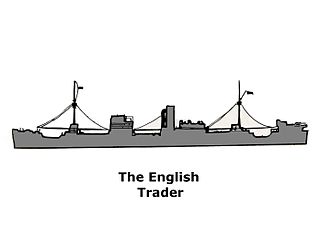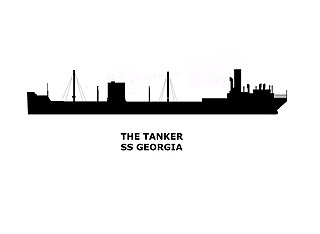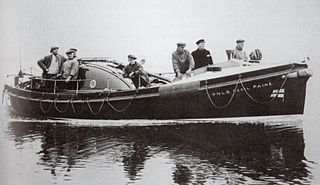
Walmer Lifeboat Station was established in 1830. Over two thousand ships are believed to have been wrecked on the Goodwin Sands, and the masts of several wrecks are visible from the shore at low tide. Hence there have always been two lifeboats located at the joined towns of Deal and Walmer along the coast opposite the sands.

The SS English Trader was a British merchant ship wrecked off the coast of Norfolk, England in October 1941. After falling behind a convoy during the Second World War of which she was a part, the ship ran aground on the Hammond's Knoll sandbank and began to break up during a gale. Several rescue attempts by lifeboats failed, but a further attempt the following day by the Cromer Lifeboat rescued 44 of the crew, three having already been lost.

The SS Mount Ida was a cargo ship built in 1938 by William Hamilton & Co. Ltd of Glasgow. Launched in 1938 as Arcscott, she was renamed Mount Ida after being bought by the Atlanticos Steam Ship Company Ltd, of Athens, Greece. She was wrecked in 1939 after being in service for only about 18 months.

SS Georgia was an oil tanker that was built in the United States in 1908 as Texas and spent most of her career in the United States Merchant Marine. In 1917 she was renamed Georgia. In 1927 she was transferred to Dutch ownership, and shortly thereafter ran aground and was lost on Haisborough Sands off the coast of Norfolk, England.

RNLB Henry Blogg was the eighteenth lifeboat to be stationed at Cromer in the county of Norfolk.

RNLB Louisa Heartwell was the sixth lifeboat to be stationed at Cromer on the coast of the English county of Norfolk She was launched from the beach station and was on station from 1902 to 1932. During her period on station at Cromer the Louisa Heartwell had only two coxswains during her 29-year career. They were Matthew James Buttons Harrison until his retirement in 1909, and then Henry George Blogg.

Sheringham Lifeboat Station is an RNLI operated lifeboat station located in the town of Sheringham in the English county of Norfolk. Since 1992, the station has been inshore operations only - currently with an Atlantic 85 rigid inflatable - offshore lifeboats are to the east at Cromer and the west at Wells-next-the-sea.

The Augusta was a private lifeboat which was stationed in the town of Sheringham in the English county of Norfolk She was launched on 14 November 1838 and stayed on station for 56 years until she was retired from service in 1894 after an inspection declared her to be unseaworthy.

SS Monte Nevoso was a cargo steamship that was launched in 1920 in England, owned in Italy, and wrecked in 1932 in the North Sea off the coast of Norfolk.
SS Gallois was one of seven merchant vessels which became stranded and then wrecked on Haisbro Sands of the Norfolk coast on 6 August 1941 during the Second World War. The SS Gallois had been part of a convoy with the designation Convoy FS 559.
SS Hopelyn was a merchant ship from Newcastle that became stranded and then wrecked on Scroby Sands of the Norfolk coast on 17 October 1922.

The Manchester Unity of Oddfellows was an Oakley-class lifeboat of the Royal National Lifeboat Institution (RNLI) stationed at Sheringham in the English county of Norfolk from 10 July 1961 until 1990 when she was replaced after 29 years service by an Atlantic 75 second generation Rigid Inflatable Boat (RIB) in May 1992. During the time that The Manchester Unity of Oddfellows was on station at Sheringham, she performed 127 service launches, rescuing 134 lives.

RNLB J C Madge was a Liverpool-class, Pulling and Sailing non-self righting lifeboat stationed at Sheringham in the English county of Norfolk from December 1904 until June 1936 during which time she was launched on service 34 times and saved 58 lives. J C Madge was replaced by Forester’s Centenary (ON 786).

Angle Lifeboat Station, Angle, Pembrokeshire, Wales, first opened in 1868 after a request from the local Coastguard for a lifeboat station to be opened within the Milford Haven Waterway. Originally called Milford Lifeboat Station, in 1892 the name was officially changed by the Royal National Lifeboat Institution (RNLI) committee.

RNLB Foresters Centenary is a retired Liverpool-class lifeboat of the Royal National Lifeboat Institution (RNLI), stationed in the English coastal town of Sheringham in the county of Norfolk in the United Kingdom. The lifeboat was on station for 25 years between 1936 and 1961 when she was sold. She has been restored to her original condition and is exhibited in Sheringham Museum.

RNLB William Bennett was the second RNLI lifeboat to be stationed at the English seaside town of Sheringham in the county of Norfolk. She served the North Norfolk coast from 1886 until 1904. Her time at Sheringham was notorious for the difficulties she had during launch and retrieval to the lifeboat station which at this time was awkwardly placed in the centre of town.

RNLB Duncan was the first RNLI lifeboat placed on station in the English coastal town of Sheringham in the county of Norfolk, United Kingdom. The arrival of this lifeboat also coincided with the construction of the first RNLI lifeboat station. The station and boat worked in conjunction with the already established private Fishermans lifeboat station also in the town.

RNLB Cecil Paine is a retired Liverpool-class non-self-righting lifeboat of the Royal National Lifeboat Institution. It was the second motor lifeboat to be stationed in the English coastal town of Wells-next-the-Sea in the county of Norfolk in the United Kingdom, and was on station at Wells from 25 July 1945 until she was sold in June 1965.
The SS Commodore was a British-registered collier. She was built at Newcastle-upon-Tyne in 1870 and served with three companies. She was driven into shallow waters off Sheringham, Norfolk on 7 November 1896. Local fishermen tried to render assistance but were driven off by gale force winds. After the Commodore was driven onto rocks she sent a distress signal and the Sheringham lifeboat Henry Ramey Upcher took off all 14 crew and 3 stranded fishermen. The wreck was blown up in 1906 as a hazard to the Sheringham fishing fleet. The remains were exposed by storms in September 2021.

The SS Fernebo was a Swedish cargo ship that was built in 1912. She was wrecked off Cromer, Norfolk, in England on 9 January 1917, being split in two by a boiler explosion or a German sea mine. Her chief engineer was killed but the remaining 17 crew members were rescued by onlookers and the Cromer lifeboat, commanded by Henry Blogg. Part of her wreck remains on the beach at Cromer but is only visible at extremely low tides.

















